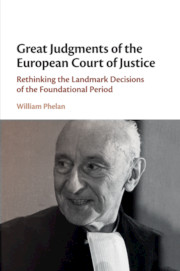 Great Judgments of the European Court of Justice
Great Judgments of the European Court of Justice Book contents
- Great Judgments of the European Court of Justice
- Great Judgments of the European Court of Justice
- Copyright page
- Epigraph
- Contents
- Tables
- Acknowledgements
- Abbreviations
- European Court of Justice Cases
- Preamble and Selected Provisions of the Treaty of Rome
- Equivalence Table of Treaty Articles
- Introduction
- 1 Pork Products, 1961
- 2 Van Gend en Loos, 1963
- 3 Costa v. ENEL, 1964
- 4 Dairy Products, 1964
- 5 International Fruit, 1972
- 6 Van Duyn, 1974
- 7 Simmenthal, 1978
- 8 Sheep Meat, 1979
- 9 Internationale Handelsgesellschaft, 1970
- 10 States and Individuals in the Great Judgments of the European Court of Justice, 1961–1979
- Bibliography
- Index
- References
Bibliography
Published online by Cambridge University Press: 04 November 2020
- Great Judgments of the European Court of Justice
- Great Judgments of the European Court of Justice
- Copyright page
- Epigraph
- Contents
- Tables
- Acknowledgements
- Abbreviations
- European Court of Justice Cases
- Preamble and Selected Provisions of the Treaty of Rome
- Equivalence Table of Treaty Articles
- Introduction
- 1 Pork Products, 1961
- 2 Van Gend en Loos, 1963
- 3 Costa v. ENEL, 1964
- 4 Dairy Products, 1964
- 5 International Fruit, 1972
- 6 Van Duyn, 1974
- 7 Simmenthal, 1978
- 8 Sheep Meat, 1979
- 9 Internationale Handelsgesellschaft, 1970
- 10 States and Individuals in the Great Judgments of the European Court of Justice, 1961–1979
- Bibliography
- Index
- References
- Type
- Chapter
- Information
- Great Judgments of the European Court of JusticeRethinking the Landmark Decisions of the Foundational Period, pp. 242 - 256Publisher: Cambridge University PressPrint publication year: 2019
